Popularity of mother of pearl
Pearlescent wall paint is suitable for treating various surfaces. Ceiling, furniture, creating decor on various products. The presence of different shades allows you to create options of different saturation and shine.
By adjusting the concentration and thickness of the coating, it is possible to create scattered sunlight on the base.
You can also get an imitation of velvet or silk coating. Sometimes pearl paint is used to achieve a concrete texture effect.
The presence of different shades allows you to create options of different saturation and shine.
How to combine with various coatings
Pearlescent paints are combined with a variety of finishes, including:
- tree;
- glass;
- drywall;
- concrete;
- Fiberboard and others.
See also
How to choose the best primer for walls under wallpaper and rules for applying compositions
But when applied to the surface, it is necessary to take into account the characteristics of the material. In particular, when processing metal, it is recommended to mix the powder with compounds that provide anti-corrosion protection. Materials that prevent rotting and mold formation are suitable for wood.
When using pearlescent dyes, the following feature must be taken into account: golden colors are not used outdoors. Such coatings do not tolerate exposure to direct sunlight (they fade).
Why did pearlescent paints become popular?
Pearlescent wallpaper paint allows you to implement many design ideas. It gives an unusual glow to the coating, resulting in a pearly shine, and is suitable for use on wood, plaster and other substrates. Such a coating is obtained due to the introduction of natural or artificial mica. This substance can give a different effect to the product; mother of pearl will be transparent or translucent. Or glass is used.
The demand for mother-of-pearl color is explained by the permissibility of painting a variety of objects inside a building with it. You can also experiment, getting different effects that look original and attractive.
The demand for mother-of-pearl color is explained by the permissibility of painting a variety of objects inside a building with it.
Technology of painting cars in white pearlescent color
It is necessary to carefully prepare for the procedure and stock up on the following materials: varnish, spray gun, substrate, base, solvent, primer, grinder.
In the field of automotive painting, pearlescent color is considered a popular shade. Black mother of pearl is in great demand.
Inexperienced craftsmen in this matter choose this option for applying the material - sequential painting with enhanced iridescent color.
Patience and attention are the main qualities required when carrying out a complex painting procedure:
1. Preliminary preparation of the body is the same as for regular painting - cleaning from dirt and dust, sanding, degreasing. The spray booth should be at the same temperature as the car.
If there is a crack on the surface, it is necessary to cover it with a primer and sand it after drying. To speed up the work and carry it out at a professional level, you need to use a grinding machine. It also minimizes the possibility that you will miss some part of the body.
Why does the composition have a velvety effect?
Decorative wall paint with a pearlescent effect can create a velvety layer. This option is achieved by introducing a special powder dye. Contact with this layer of sunny people leads to their visual bending.
To add powder from reflective dyes, you can only choose a water-based paint, often acrylic-based paint.
How strongly the rays will be refracted is determined by the amount of dye added to the composition. This is how they reach velvet walls after applying the pearlescent composition.
Decorative wall paint with a pearlescent effect can create a velvety layer.
How to create a mother-of-pearl wall design: advises Pufas
We are considering several popular options together with the Pufas company and focusing on one of the most interesting ways to decorate walls.
Walls in a modern interior have long ceased to be a “faceless” background. Now designers assign them a rather significant role. The walls can be monochromatic, but in relief, creating the effect of the versatility of the space, or quite actively decorated, setting the mood for the entire interior. One thing is clear - walls should not be boring under any circumstances. Fortunately, the choice of materials for wall decoration today is very rich. And the mother-of-pearl, shimmering walls look especially charming.
How to create a mother-of-pearl effect on walls
The most common material is wallpaper
. Finding wallpaper with a mother-of-pearl effect is not difficult. Yes, and you can glue them yourself by choosing the right glue. However, not all design ideas can be realized with wallpaper.
Decorative paints
- This is an alternative to wallpaper, but it will be quite difficult for a person inexperienced in repair work to achieve an ideal result on their own, since all the imperfections can be visible on a smooth surface. But there are a great variety of shades, including mother-of-pearl, in which the paints are produced.
Mother of pearl plaster
– an excellent solution for original design projects for wall decoration. Modern plasters surprise not only with a variety of colors, but also textures.
For those who want to create a sophisticated and unusual wall design, Pufas recommends paying attention to its new product - Crystal-Finish
. This is a mother-of-pearl finish with small round glass crystals, designed for decorative finishing indoors. It is applied to walls and ceilings, creating a unique pattern on the surface, exquisite shimmer and the effect of “depth”. Thanks to this finishing material, the texture of the wall becomes elegant and structural. Round, glass crystals bound with acrylate form a highly durable coating after drying.
This job does not require professional training. With decorative coating Crystal-Finish
You can not only skillfully hide minor errors on the surface of walls and ceilings, but also give the room a stylish appearance.
Crystal-Finish itself is already a very beautiful finishing material of white pearlescent color, but for an individual color design it can be tinted to any desired tone. To do this, you need to mix Crystal-Finish directly into a container with universal tinting concentrates (for example, pufaMIX) or Metal Effect pigments (maximum addition of 10%).
Applying pearlescent finish
Crystal-Finish
Can be applied to all mineral substrates, including those painted with dispersion paint. The material is suitable for decorating surfaces made of plaster, concrete, gypsum, and plasterboard.
How to prepare the base?
The substrate must be clean, dry, durable and free of grease stains.
Prime highly absorbent substrates, sand, chalk, gypsum. Any damage on the surface must be repaired with putty for interior work (for example, Pufas
).
If the substrates have color differences, we recommend priming them either with a white primer (PUFAS) or painting them white with dispersion paint. In both cases, the material can also be tinted in the same tone as it is planned to tint Crystal-Finish
.
How to apply Crystal-Finish?
To apply the pearlescent finish, use a paint brush - apply it freely, but without skipping.
Then smooth the applied coating with a leveling trowel. The maximum thickness of the applied layer is 5 mm. Drying time for the coating is approximately 12 hours, depending on the room temperature. Tools should be rinsed immediately with water after using Crystal-Finish
.
So, upon completion of the renovation work, you will receive elegant walls with an unusual, “deep” and pearl-velvet texture, which, from different viewing angles, changes its appearance depending on the lighting. In addition to the beauty of execution, you will also be pleased with the high strength and wear resistance of the surfaces.
How can pearlescent paint be produced?
Mother of pearl for decorative plaster or another type, it is important to choose the right option for a particular job. For this reason, it is worth exploring the main options that are on sale:
- Powder look. when you can add the product to acrylic paint yourself. Then you can adjust the saturation and the resulting effect. But if you have little experience, you can make a mistake in preparing the solution, and lumps may form in it;
- Pastes, which are more convenient to prepare, are also introduced into acrylic paint, and a variety of shades and brightness are created. But the shelf life is short, you need to apply the pigment sooner after purchase;
- A ready-made coloring composition that is most convenient for beginners. After all, you don’t have to mix the components and you can immediately start painting the base.
The ready-made coloring composition is most convenient for beginners.
Features of the “three-layer”
Three-stage coating is a type of “base + varnish” coating.
The “three-layer” is based on a layer of base substrate of one color or another, on top of which a layer of “spectacular” paint is applied and this “sandwich” is completed - a transparent varnish. As a rule, this coating has a mother-of-pearl effect, the main components of which (microscopic mica particles) are located in the second layer.
The first feature of this coating is that the mother-of-pearl layer is highly transparent - we “see a little” of the substrate underneath it. This gives a special visual effect to the “three-layer”: mother-of-pearl particles are “illuminated” from all sides, both from above, through a layer of transparent varnish, and from below, by light reflected from the substrate.
At the same time, this transparency of the mother-of-pearl layer creates certain difficulties when touching up.
The essence of the problem can be formulated as follows. If the substrate is visible under the mother-of-pearl, then its border may also be noticeable when touching up the paint. An attempt to cover this border with additional layers of mother-of-pearl sometimes gives a positive result, but significantly changes the shade of the enamel. And this is unacceptable.
Second feature. Since the color characteristics of a three-layer coating strongly depend on the thickness of the second, transparent layer, when repairing a three-layer coating you never know in advance how many layers of pearlescent paint will need to be applied. Moreover, not only the number of layers is important, but also the individual manner of application - each master produces a slightly different layer thickness. That is why pearlescent repair paint, as a rule, is not tinted, but is prepared strictly according to the formula.
And in order to determine the number of layers that will need to be applied, it is recommended to perform some kind of preliminary test before starting painting. With some skill, its implementation will not require a lot of time and a large amount of materials, and at the same time it is guaranteed to protect against mismatch of shades on the repaired and undamaged surfaces.
Pearlescent paints for walls
Pearlescent plaster for walls is also popular. But still paint is used often. It helps to obtain a pearly shine on the surface, while the saturation may vary. Can be used on different bases. Next we will look at how the effect is achieved.
Paint helps to obtain a pearly shine on the surface, and the saturation may vary.
What provides this shade?
The rainbow effect is obtained when ultraviolet light refracts the shine that is formed due to the presence of mica and glass in the composition. If natural mica is chosen, the appearance will be opaque, artificial mica will be translucent, glass will give a colorless coating:
- The dye is small particles that stand out with gloss and shine, contributing to visual depth;
- For a metallic effect, aluminum or bronze powder is used;
- The size of the granules and the number of layers affects the result and the shade of the coating;
- The paint comes in basic colors - gold, silver or pearl.
The rainbow effect is obtained when ultraviolet light refracts the shine that is formed due to the presence of mica and glass in the composition.
Relevance
Designers love to use mother-of-pearl coatings; they are applied to furniture, walls, ceilings, and for decorating small objects. It is not difficult to achieve unusual results using the product; you can do the work yourself.
Designers love to use mother-of-pearl coatings; they are applied to furniture, walls, ceilings, and for decorating small objects.
Application
There is a wide range of application of the product. Suitable for processing the following substrates: wood, glass, concrete, chipboard, plasterboard and other lumber.
There is a wide range of application of the product.
Combinations
To correctly select the material for other means, you need to know the possible combinations:
- You can use different types of paints together - oil, alkyd, water-based;
- If wood is being processed, it is advisable to add the dye to the wax or plaster solution;
- Ready-made paints are selected for painting work.
Ready-made paints are selected for painting work.
Instead of paint and wallpaper: 8 new wall coverings
Of course, you can choose wallpaper or paint to decorate the walls the old-fashioned way. But wallpaper is not the most environmentally friendly finishing option, and ordinary paint is not always an original solution. Moreover, now there are many interesting and, importantly, practical options. We learned which ones from a Loggia expert.
Textured coatings
The most popular type of decorative plasters today allows you to create a variety of effects: marble, cement, metal. And with their help you can decorate a vintage interior - for example, there are coatings with imitation of aged surfaces - rust or worn marble.
Textured coatings are suitable for absolutely any interior style, even minimalist Scandinavian. For example, the Volare material is finely dispersed lime; from a distance it looks like smooth paint, but at the same time it has its own texture and a soft surface with a soft-touch effect. Very wear-resistant and fits perfectly into any interior.
Price:
from 615 rubles per square meter.
Imitation fabric
Coverings for denim, velvet or silk that contain fiber. In fact, this is natural silk: it is plastic and can even contain microcracks during shrinkage of the house, so it is perfect for new buildings.
Coarse silk with Montenapoleone fiber fiber has an interesting texture - it is quite matte, but at the same time, depending on the light and application, it can produce any pattern.
And more recently, an innovative coating has appeared - floor silk with a soft-touch effect, which is also compatible with heated floors.
Price:
from 602 rubles per square meter.
Effetto Platinum Argento
Oro Puro Lucido
Plasma 3D
This is an innovative polymer coating that can be applied to any surface, including furniture and floors, over old laminate or tiles. It allows you to create a variety of effects - imitate marble, wood and even snake skin. In addition, Plasma 3D is a water-based polymer, so it can be used in conjunction with heated floors.
More recently, Loggia has improved this coating: this is how BiPlasma 3D was born - a two-component material that is applied very quickly and allows, for example, to change floors in just one day.
Price:
from 1770 rubles per square meter.
Sands
This group of materials is called “sands”, since they contain real natural quartz sand or synthetic fiberglass of different granulations, and are based on a mother-of-pearl or deep-matt component. The choice of these materials is also very diverse: with the effect of sandy winds, sea waves, clouds with a 3D illusion.
It is important that the service life of “sand” plaster is more than ten years. At the same time, the texture and brightness of colors are preserved in their original form. This is a good solution for high-traffic areas, for example, in corridors.
Price:
from 462 rubles per square meter.
Venetian
The most ancient type of plasters in the truest sense of the word. Who first invented Venetian plaster and when it happened is unknown, but during the Renaissance, Italian masters already mastered “marbled wall painting.”
It is surprising that a decorative coating that imitates marble comes from a country that has never had problems with this finishing material. Loggia has several options for Venetian plasters, both the “original” thousand-year-old recipe - based on marble chips or with the addition of beeswax, and synthetic modern materials.
This material is often skillfully used to imitate marble, if it is not possible to line walls with it, and is also used in wet areas - bathrooms or swimming pools.
Price:
from 350 rubles per square meter.
Pearlescent paint for different interiors
To make it easier to decide which style to choose, you need to know some techniques for proper use in the interior, adding to decor and varnish products:
- The use of special devices, rollers. brushes, etc., so that the layer is textured, and drawing on the base;
- Old finishing material is covered with mother-of-pearl to lighten it and improve its appearance.
Old finishing material is covered with mother-of-pearl to lighten it and improve its appearance.
How to paint a car with pearlescent paint? Tips from the master
The mother-of-pearl effect on car enamel can look especially chic. Of course, it will only be visible in daylight, and in sunny weather. However, this effect cannot be compared with metallic, although it is very similar.
The play of light is very diverse - there are not only unusual reflections when a car is painted with mother-of-pearl, the same reflections also change color, depending on many factors. The main factor is the paint itself, but application technology is no less important.
Painting parts with mother-of-pearl is quite expensive. Moreover, the paint itself is not much more expensive than standard “metallic”. You can save money if you do the work yourself, especially since the work in this case costs the most. Moreover, it is not as difficult as the masters may tell you when they offer to use their services.
Technology for obtaining mother-of-pearl effect
In general, pearlescent paint is produced using approximately the same technologies as metallic paint. However, it is not the smallest particles of metal that give the unusual shine, but the smallest particles of mica.
The difference is that mica is translucent. If metal simply reflects light, according to optical laws, then mica no longer only reflects it. Or rather, it reflects, but also from the outer edge and from the inner one, where it passed through the thickness of the material. This is what causes the color change, all according to the laws of physics.
After all, light is an electromagnetic wave, and when the reflected rays are added out of phase, a peculiar picture is obtained, with many different wavelengths, and therefore with many color shades. But painting a car with mother-of-pearl is not as simple as it initially seems. Unless, of course, you take into account a number of nuances, and if you take into account...
Composition by layers of paint layer
In general, two main components are used - paint and varnish. Much is similar to working with metallic, but there are a number of differences. So several layers of varnish are needed to get the effect of depth. And the layers of varnish themselves will differ, and in composition.
In addition, applying paint is not so easy - after all, it is necessary to achieve symmetry of reflections. Those. the color flow should be symmetrical to the car body. Let's look at how to achieve this. What materials will be needed:
- Paint base;
- Special pearlescent pigments;
- Varnish;
- Solvent.
There are already mixed formulations, but it is better to purchase them separately, which will allow you to achieve the maximum, and most importantly, the desired effect. Only the components must be from the same manufacturer, otherwise a chemical conflict may occur. He can express himself immediately - the paint will simply curl up, or maybe later (for example, in a year the layers will begin to crumble). Therefore, saving is not appropriate here.
Painting a car with mother of pearl, the process itself
First of all, the element itself that is being painted is necessary. Prepared at that. Those. car, or part of it (door, fender, etc.). Prepared - meaning clean and straightened, completely ready for painting. Preferably covered with a special primer – i.e. not the transport one (with which the parts come in the form of spare parts - it must be removed), but the one intended for paint.
equipment requirements
In addition, what you need to have:
- High-quality spray gun – for applying layers of paint;
- A compressor that creates a smooth air flow, without pulsations and with filtered air;
- A set of painting materials (solvent, paint, varnish and pigments).
A special dust-free room is also necessary, i.e. paint booth. This is where the enthusiasm of garage craftsmen often dries up, but there is no need to panic. It’s easy to make a dust-free garage room - just do a wet cleaning and organize fresh ventilation, with filtration of the incoming air.
In addition, painting a car with mother-of-pearl adds another requirement to the room - temperature control is required. A positive temperature in the room is important, and uniform throughout the entire volume. But in garage conditions this is quite possible to do.
Apply pearlescent paint
First, a layer of paint is applied. It is necessary to add pearlescent pigment to it and dilute it in appropriate proportions. It is also necessary to dilute the resulting mixture with a solvent, and for garage conditions it is necessary to make it drier. Those. If a 1:1 dilution is usually used, then you need to use two parts paint to one part solvent.
Working with a spray gun is different and more precise than even when using “metallic”. The gun must always be kept at an equal distance from the surface, and movements must be made only in one plane, one direction and at one speed.
Nuances of color selection
The effect of the products can be different, not just pearlescent. Bronze or aluminum powder makes it possible to create a metallic effect.
As standard, only pearl, gold and silver shades are offered for sale. Other tones are obtained by introducing pigment, manually or mechanically.
The use of special equipment allows you to accurately repeat the resulting shade, which is required for large areas, so in this case it is advisable to carry out tinting in stores.
The use of special equipment allows you to accurately repeat the resulting shade, which is required for large areas.
Sand dune at your home
Pearlescent paint with sand is very interesting for decoration. It is chosen by fans of oriental style, classics, and techno. But unlike decorative plaster, this paint emphasizes all the imperfections of the walls: obvious flaws, unevenness. Therefore, the preparatory stage is especially important - the walls must be absolutely even and smooth.
Two layers of soil are laid on them: deep penetration acrylic and special quartz. Apply the base paint of the selected color with a roller. A little sand is evenly applied to the wall with a brush, after which it is smoothed, creating the necessary decorative effect. The technology is not too complicated, but it is better to contact a specialist.
Pearlescent paint on the bedroom wall
Combination with different coatings
Compatibility with various surfaces is good. You can use the funds in the following ways:
- Suitable for painting: alkyd, oil and water-dispersion paints;
- It is better to cover a wooden base with plaster or wax with mother-of-pearl;
- For painting processes, ready-made products are used.
It is better to cover a wooden base with plaster or wax with mother-of-pearl.
Decor varies
Acrylic paint with mother-of-pearl is added to decorative plaster. The ratio of the amount of mother-of-pearl and varnish gives a different decorative effect. The predominance of varnish scatters light more strongly and highlights one shade. The impressive layer of varnish allows only a slight glow of the layers.
The preponderance of pearlescent paint in the varnish creates brighter and deeper shimmers. The paint color plays a secondary role here; it only gives the desired shade to the glossy surface. But excess shine or radiance is tiring for the eyes and psyche, so individual elements of the interior or small segments of the walls or ceiling are emphasized in this way.
With a slight addition of mother-of-pearl to the varnish, the surface plays with new shades and colors. Mother of pearl gives a soft, mysterious shimmer that creates harmony and comfort.
By experimenting, you can always choose the option that suits you.
Pearlescent paint on the wall in Greek style
Mother-of-pearl paint in apartment decor
Pearlescent paint in a modern interior
How to apply
Paint can be applied with various devices, the end result will be slightly different. Therefore, the use of mother-of-pearl is considered an opportunity to create different design ideas.
Paint can be applied with various devices, the end result will be slightly different.
Sponge
The sponge is intended for creating patterns and is not used to completely paint the base. First, the sponge is moistened and squeezed out well before immersing it in the paint, from the excess of which it will also need to be freed.
The sponge is intended for creating patterns and is not used to completely paint the base.
Brush
It is used for processing corners and hard-to-reach areas; large areas are difficult to cover. Also, the consumption of funds will be large. If you choose two round brushes, you can apply an unusual pattern of two shades, for example, white and blue, they are painted chaotically.
It is used for processing corners and hard-to-reach areas; large areas are difficult to cover.
Spray gun
The tool helps to quickly and evenly apply the composition to the entire base. But a more liquid consistency of paint is used, to which water is added.
The tool helps to quickly and evenly apply the composition to the entire base.
Roller
A foam roller is used for painting. It can also reduce the labor intensity and time needed to cover the entire base. There are rollers with a textured surface. to create an unusual textured base when painting.
A foam roller is used for painting.
Brush
The brush is easy to use, but it takes a lot of time. Working in large rooms is difficult. Typically used for painting small objects or hard-to-reach areas.
The brush is easy to use, but it takes a lot of time.
Putty knife
The pearlescent composition is viscous, for this reason a spatula can be used to distribute it. You can choose a spatula made of metal or plastic.
The pearlescent composition is viscous, for this reason a spatula can be used to distribute it.
Tools and application technology
There are no special tools for applying pearl effect paint.
You can use the same methods as when painting walls and ceilings with other types of paint and varnish coatings:
- foam sponge;
- spray gun;
- brush or brush;
- paint roller;
- Venetian trowel;
- putty knife.
Additional tools are required in some cases for more precise decoration. For example, if you need to paint not the entire surface, but a fragment of it, use masking tape.
Tools used for applying pearlescent paint.
All work on finishing the room can be divided into 3 stages: preparation, painting and decoration.
At the first stage, you need to carefully inspect the surface being treated for any defects: chips, unevenness, roughness or cracks. All these shortcomings need to be eliminated. Uneven walls or ceilings are leveled with putty, and the protrusions are cleaned or knocked down. It is important to thoroughly clean the surface from old coating or stains.
After this, the wall to be painted is primed with a material whose color will match the decorative paint. The primed surface dries in 6-8 hours depending on the composition used. During this time, you can prepare mother-of-pearl enamel, if it was not purchased ready-made. If necessary, the material is tinted with various pigments.
Next, use a narrow brush to make a starting line. When it comes to painting walls, it is done under the ceiling. Its width is 5-10 cm. The presence of this border reduces the risk of staining the ceiling if, for example, a paint roller is used.
After this, a continuous background (aka base) layer of paint is applied. It dries within an hour, although some formulations may require only 30-40 minutes.
Then the dried surface is covered in fragments with a second layer of mother-of-pearl enamel. This is the decorating stage, when the desired visual effects are created using various tools. Particular expressiveness is achieved when using a material 1 or 2 shades lighter than the base. To do this, you can mix the untinted composition with the tinted one in a 1:1 ratio.
At all stages of work, it is better to use compounds from one manufacturer, because this is a guarantee of greater compatibility between them. The exception is the situation when the paint is made independently.
If all rules are followed when painting, the material consumption is 200 ml per 1 sq.m.
Soft sponge
The texture of the foam sponge is suitable for creating various patterns and ornaments. Therefore, it is used at the stage of additional decoration, but not when working over the entire surface.
Before work, the sponge should be moistened with water and squeezed out well. To avoid smudges, the instrument is lightly dipped in paint and then, if necessary, blotted with a sheet of paper. They work with it either in a circular motion or with light pressure against the wall.
Spraying with a spray gun
This tool ensures uniform distribution of the composition over the surface to be painted. In this case, the paint must be diluted with water (in this case, dilution by 40% is allowed), otherwise the tool will clog. The consistency of the diluted material resembles sour cream. If for some reason adding water does not seem appropriate, it is better to use another tool.
When using a spray gun, the paint applies perfectly and the work is completed quickly.
Brush
This tool is more suitable for working in small areas. When painting an entire wall, using a broom or brush will waste material and may require a lot of physical effort.
It is advisable to use a brush when decorating corners, hard-to-reach areas and areas with complex terrain (for example, behind batteries).
An unusual effect is obtained when using 2 round brushes. Each of them is dipped in a pigment of different colors (for example, white and blue). Their combination and chaotic application will be useful when creating drawings on the wall.
Paint roller
At least 3 such rollers will be required, since the work takes place in several stages.
The tool can be made of various materials, so the following nuances should be taken into account:
- fur is more suitable for priming the surface;
- velor is used for basic coloring;
- foam rubber is used for coating with mother-of-pearl composition.
To create various wall drawings, you can additionally acquire a textured roller or use a regular rag. It is dipped in paint, squeezed out, twisted into a rope and wound onto a paint roller. After these manipulations, you can start decorating. Using such a tool creates the effect of “crumpled walls”.
A paint roller allows you to distribute the paint evenly and economically. In addition, it is the easiest way to create clear boundaries between different areas of the surface.
Using a paint roller you can quickly and evenly distribute the paint composition over a large area.
Application with a spatula
The high viscosity of pearlescent paint makes it possible to use a spatula. Both metal and plastic tools are suitable. The optimal spatula width is 80 mm. Sometimes this tool is auxiliary. For example, it is convenient for them to distribute material over a trowel, which is then used for decoration. The trowel and spatula can be replaced with a textured roller.
DIY paint
You can make your own paint. You will need: pearl powder; gum arabic. They are available for sale in art departments. The ratio is as follows: one part of the second component is added to 3-5 parts of powder. The consistency of the solution should be thick; water can be added if necessary.
The consistency of the solution should be thick; water can be added if necessary.
Application of the substrate
The next step is applying the base coat. To do this, there is no need to wait for the colorless base to dry. After applying it, you need to drain the remaining mixture from the tank, lightly rinse the gun, pour the substrate into it and immediately begin application, since only a semi-wet layer can ensure the correct orientation of the metal particles (if it is a “showy” substrate) and complete absorption of pollen.
The base substrate is applied in 2-3 layers, each of which should cover a larger area than the previous one. Waiting time between layers is 5-10 minutes at 20°C.
Sometimes it is recommended that after applying two covering layers, add a certain amount of “pure” mother-of-pearl to the base composition and apply another 1-2 layers of this mixture to the surface, gradually expanding the area to be painted. This technology allows you to bring the base shade as close as possible to the mother-of-pearl layer and thus make its border invisible. But remember, in order to “crank out” this action, the base and pearlescent paints must be prepared in the same resin system.
Another important point. Since the thickness of a three-layer coating is greater than that of a conventional two-layer coating, there is a possibility of a decrease in the adhesion and strength characteristics of the coating during further operation. To prevent this, manufacturers often recommend adding a hardener to the substrate - this increases the adhesion between the layers.
How to do the work yourself
You need to work with a cleaned and leveled base. It is required to obtain a defect-free surface and apply a primer solution. Paint the dried surface:
- The composition for painting is being prepared;
- Make the first base layer;
- After drying, the base is covered with a layer of mother-of-pearl.
It is required to obtain a defect-free surface and apply a primer solution.
How to make a room pearly white
The white shade is picky about imperfections; for this reason, the walls must be well prepared to avoid unevenness. The composition is applied in the usual way. You can choose plaster or paint for the effect.
The white shade is picky about imperfections; for this reason, the walls must be well prepared to avoid unevenness.
Chameleon effect
Chameleon paint for walls is becoming even more popular in apartment design. A special pigment is used, which is more noticeable against a dark background. Visually, the dye is able to cover the imperfections of the base.
It is advisable to choose a spray gun or an airbrush as a tool.
Visually, the dye is able to cover the imperfections of the base.
Pink pearl
The pink effect helps give a calm and gentle look to the room. Painting is no different from regular painting. You can use rollers, brushes, sponges, etc.
The pink effect helps give a calm and gentle look to the room.
Classic white pearl
This coating gives a luxurious and noble look to the walls. It is important to paint a well-prepared base so that there are no flaws that white will strongly emphasize. You can apply the paint like any other paintwork material.
It is important to paint a well-prepared base so that there are no flaws that white will strongly emphasize.
Creating Effects
Mother-of-pearl compositions, through the use of certain techniques, allow you to create different effects on the surface.
Chameleon
To create this effect, you will need a special pigment, thanks to which, depending on the viewing angle, the color of the coating changes. This composition is also recommended for treating uneven surfaces. The chameleon effect pigment should be applied using an airbrush or spray gun.
Pink pearl
Mother of pearl in combination with pink pearl color can make the interior more romantic. This paintwork material is combined with a gray, blue or white coating. In this case, a roller or sponge is also used to create a specific pattern on the surface.
Design tips
When decorating the interior, the following parameters are taken into account: room area; its purpose; lighting saturation. For example, if the lighting level is good, then you can cover the walls with a blue tone without adding mother-of-pearl. The second layer is made of mother-of-pearl, but preferably of a different shade, so that the iridescence becomes more interesting. Light colors increase space.
Light colors increase space.
Mother-of-pearl compositions are used for various purposes. It is so popular to add when decoupage, when painting cars, and in the interior. The variety of options and ease of operation have made the product in demand.
Application of “mother of pearl”
15-20 minutes after applying the substrate, we smoothly spray the required number of layers of mother-of-pearl (the amount was determined by the test) with a wait of 5-10 minutes between them.
The mother-of-pearl must be applied so that the area of paint covers the applied substrate, but does not extend too far beyond its border.
Remember that the thickness of the mother-of-pearl layer greatly affects the shade. Therefore, if two or three layers of mother-of-pearl are required to obtain the desired shade, you still need to “enter” the transition zone with only one layer.
To do this, it is recommended to use the narrowing method shown in the diagram below. The first layer is applied to a larger area, and the second to a smaller one, remaining “inside” the first layer. Thus, at the junction of the old and new coatings, we will always have only one layer of mother-of-pearl and the repair boundary will not be noticeable, since the paint is transparent and the color transition will look smooth.
Decoration options
Depending on the concentration of pigment contained in acrylic enamel, two design options can be used.
Strong concentration
With a high concentration of pigment, the color of the paint plays a secondary role, giving only the necessary shade to the shiny surface. This dye is rarely used in large quantities: the ceiling or walls painted with it will become tiring with their bright light-refracting effect, and it will not be very comfortable to be in such a room.
Creating a Coverage
When using ready-made decorative paints, painting with mother-of-pearl yourself is not a particular problem. The most important thing here is high-quality preparation of the base, which must be leveled, well sanded, and impregnated with deep penetration soil. In general, there is nothing new in this - the surface is prepared in the same way for any painting and wallpapering.
As for the methods of applying paint, its drying time, consumption and other nuances, there are manufacturer’s instructions for this, which you need to carefully read, and a video that it is advisable to watch before starting work.
Tools
Each manufacturer of decorative paints offers primers, colors, and base paints that are applied under mother-of-pearl. You just need to familiarize yourself with the product line of the selected manufacturer and application technology. Also, you should stock up on the necessary tools - and you can get to work.
In what form is it produced?
On construction markets, this pearlescent pigment can be purchased in the following forms:
- Powder. It is convenient because it can be added to any acrylic dye to create the desired color, creating a color palette and adjusting the degree of light reflection. The downside is that if the master does not have experience, the material may be diluted unevenly, and when mixed with water-based enamel, lumps may form.
- Paste. It is convenient for diluting with acrylic enamels, it allows you to get a large color palette for decoration and when mixed it gives a homogeneous mass. Minus - compared to powder, it does not have a very long shelf life.
- Ready-made enamel with pearlescent color. Very convenient for beginners or in cases where complex decorative finishing is not planned, but just needs to be painted on the walls or ceiling.
Acrylic enamels with the addition of pearlescent pigment after drying are very durable, resistant to environmental influences and do not require additional protection. They can be used as a finishing touch to the facade, to create various graffiti on fences, or to decorate the walls and ceilings of interior spaces.
A dye with a light-refracting effect has only a slight limitation regarding color: the color of gold can only be used for interior decoration; it quickly fades under direct exposure to ultraviolet radiation.
The silver color has increased durability and weather resistance, so it can be used with any coloring options.
Common tone - white pearl
Transforming a car into such a seemingly simple color tone as white mother-of-pearl will require remarkable skill. The slightest disregard for technology will add rainbow shades to the color scheme.
Based on the painstaking nature of the process, a car enthusiast can choose a snowy metallic color, but the varnish will not be able to realize the effect of a white iridescence.
Coating the metal of a car with a capricious color will require careful selection of materials involved in the process. Paint will not be able to mask surface imperfections; it will only concentrate attention on them. Therefore, the logical choice of painting scheme is three-layer:
- The surface is degreased, primed, and a white base is sprayed;
- The second stage is the application of base paint with a pearlescent component;
- The final operation is varnishing.
Painting materials for a similar color scheme should be purchased from the same brand, otherwise the surface may peel off after a certain period of time.
The ideal size of crushed mica as an additional pigment in white pearlescent paint is 201-218. This size range of mica helps prevent the appearance of unwanted iridescence; the surface turns out to be white with a pearl shimmer.
Stage 2 – painting with pearlescent composition
The further process is carried out according to this principle:
- Take the paint. If necessary, the pearl composition is tinted. The paint is mixed until smooth. Here you can dilute the paint and varnish material with water, no more than 10-15% of the total mass. Everything is thoroughly mixed.
- Using a narrow brush, apply a starting line under the baguettes. Its width is from 5 to 10 cm. It is needed for the convenience of subsequent application with a roller. In this case, the ceiling will not be dirty.
- After which the first layer is applied. This is the base or background. It is recommended to apply it with a velor roller. This is not difficult to do, it just requires patience and accuracy.
- Pearlescent paint is poured into a paint tray. Then you need to dip the roller into the bath and transfer the paint to the surface. It is important to do this evenly.
- After applying the base coat, you need to leave everything until completely dry.
To make the surface original, you need to apply a decorative layer. Appropriate paint is used. Its application will be done using a spatula. The paint is applied in strokes, like putty. As the second coat is applied, the surface will become silky. The effect is enhanced by the following layers. The movements are chaotic in order to create an original pattern on the surface.
What can be painted
You can decorate any surface from:
- wood;
- glass;
- concrete;
- drywall;
- Chipboard and other similar materials made from wood chips.
Pearlescent paint with an original decorative effect has the same qualities as acrylic enamel. Often, various components are added to water-based acrylic dyes to provide a protective effect. For example, for metal it will be anti-corrosion protection, and for wood it will be prevention of rotting or fungal development. The presence of additional additives does not affect the decorative qualities in any way, but allows you to additionally protect the wood or metal from destruction during decoration.











